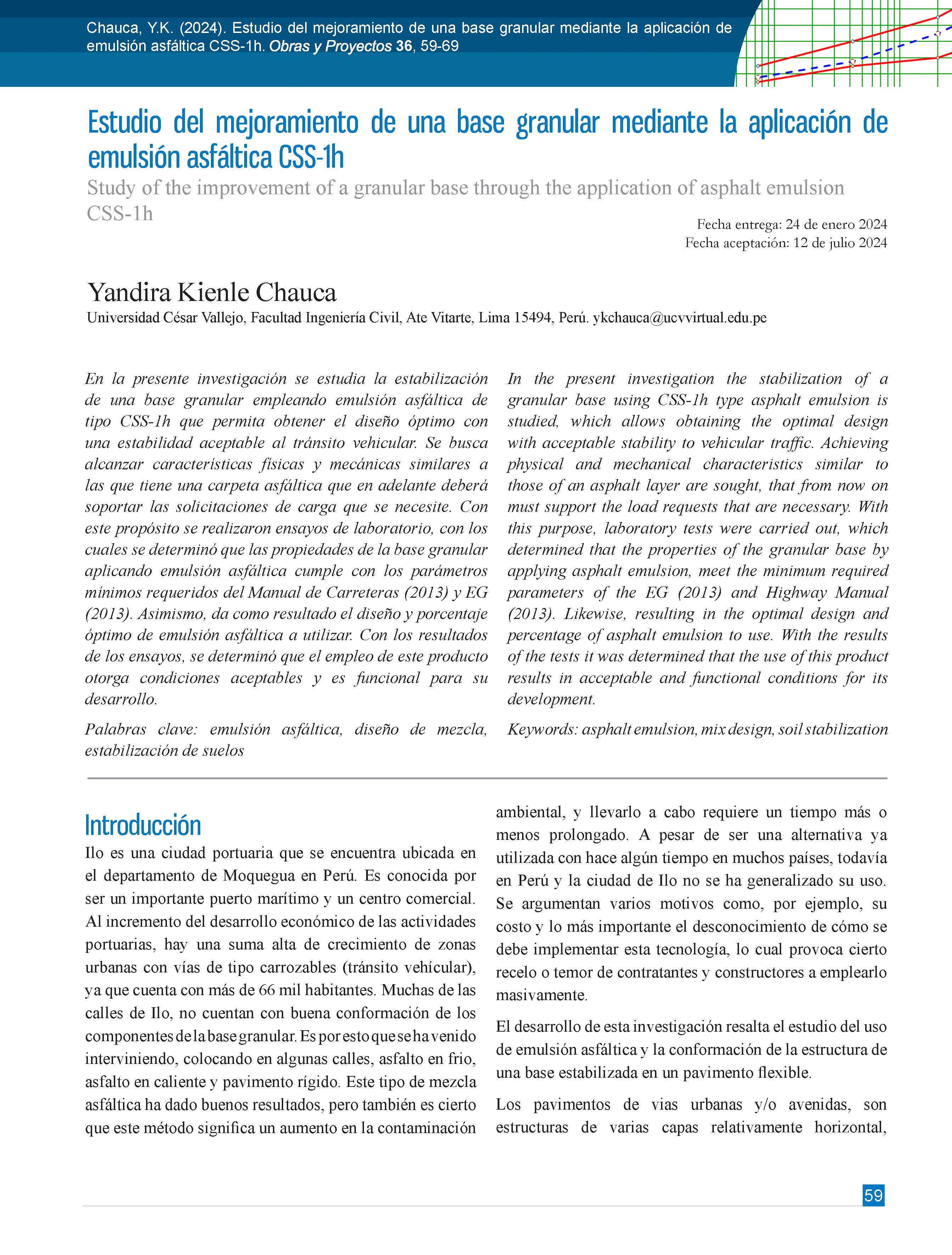Study of the improvement of a granular base through the application of asphalt emulsion CSS-1h
DOI:
https://doi.org/10.21703/0718-2813.2024.36.3006Keywords:
Asphalt emulsion, Mix design, Soil stabilizationAbstract
In the present investigation the stabilization of a granular base using CSS-1h type asphalt emulsion is studied, which allows obtaining the optimal design with acceptable stability to vehicular traffic. Achieving physical and mechanical characteristics similar to those of an asphalt layer are sought, that from now on must support the load requests that are necessary. With this purpose, laboratory tests were carried out, which determined that the properties of the granular base by applying asphalt emulsion, meet the minimum required parameters of the EG (2013) and Highway Manual (2013). Likewise, resulting in the optimal design and percentage of asphalt emulsion to use. With the results of the tests it was determined that the use of this product results in acceptable and functional conditions for its development.
References
AASHTO T104 (2003). Standard method of test for soundness of aggregate by use of Sodium sulfate or Magnesium Sulfate. Washington DC, USA.
AASHTO (1993). Guide for design of pavement structures. American Association of State Highway Transportation Officials. Washington DC, USA.
AASHTO T96 (2002). Standard method of test for resistance to degradation of small-size coarse aggregate by abrasion and impact in the Los Angeles machine. Washington DC, USA.
ASTM C88 (2018). Standard test method for soundness of aggregates by use of sodium sulfate or magnesium sulfate. West Conshohoken PA, USA.
ASTM C131 (2010). Standard test method for resistance to degradation of small-size coarse aggregate by abrasion and impact in the Los Angeles machine. West Conshohoken PA, USA.
ASTM D244 (2014). Standard test methods and practices for emulsified asphalts. West Conshohoken PA, USA.
ASTM D422 (2014). Standard test method for particle-size analysis of soils. West Conshohoken PA, USA.
ASTM D1241 (2015). Standard specification for materials for soil-aggregate subbase, base, and surface courses. West Conshohoken PA, USA.
ASTM D1888 (1985). Standard test methods for particulate and dissolved matter, solids, or residue in water. West Conshohoken PA, USA.
ASTM D2397 (2020). Standard specification for cationic emulsified asphalt. West Conshohoken PA, USA.
ASTM D3910 (2021). Standard practices for design, testing, and construction of slurry seal. West Conshohoken PA, USA.
ASTM D4791 (2010). Standard test method for flat particles, elongated particles, or flat and elongated particles in coarse aggregate. West Conshohoken PA, USA.
ASTM D5821 (2013). Standard test method for determining the percentage of fractured particles in coarse aggregate. West Conshohoken PA, USA.
ASTM D6933 (2008). Standard test method for oversized particles in emulsified asphalts (sieve test). West Conshohoken PA, USA.
ASTM D6934 (2004). Standard test method for residue by evaporation of emulsified asphalt. West Conshohoken PA, USA.
ASTM D6935 (2011). Standard test method for determining cement mixing of emulsified asphalt. West Conshohoken PA, USA.
ASTM D6936 (2004). Standard test method for determining demulsibility of emulsified asphalt. West Conshohoken PA, USA.
ASTM D6997 (2012). Standard test method for distillation of emulsified asphalt. West Conshohoken PA, USA.
ASTM D6998 (2004). Standard practice for evaluating aggregate coating using emulsified asphalts. West Conshohoken PA, USA.
ASTM D6999 (2004). Standard practice for miscibility of emulsified asphalts. West Conshohoken PA, USA.
Botasso, G. y Segura, A. (2013). Estudio experimental de microaglomerado asfáltico antiderrapante modificado con NFU. Obras y Proyectos 14, 36-44.
Castiblanco, J.W. (2015). Uso de micropavimento para adecuación de vias municipales. Tesis de grado, Universidad Militar Nueva Granada, Colombia.
Manual de Carreteras (2013). Suelos Geología, Geotecnia y Pavimentos. Sección de Suelos y Pavimentos. RD N° 10 – 2014. Resolución Directoral N° 05-2013-MTC/14. Ministerio de Transportes y Comunicaciones MTC, Perú.
MTC E107 (2014). Análisis granulométrico de suelos por tamizado. MTC, Perú.
MTC E111 (2014). Determinación del Límite Plástico (LP) de los suelos e Índice de Plasticidad (IP). MTC, Perú.
MTC E 114 (2014). Método de ensayo estándar para el valor equivalente de arena de suelos y agregado fino. MTC, Perú.
MTC E 115 (2014). Compactación de suelos en laboratorio utilizando una energía modificada (Proctor modificado). MTC, Perú.
MTC E132 (2014). CBR de suelos (laboratorio). MTC, Perú.
MTC E207 (2014). Abrasión Los Ángeles (LA) al desgaste de los agregados de tamaños menores de 37.5 mm (1½”). MTC, Perú.
MTC E 209 (2014). Durabilidad al Sulfato de Sodio y Sulfato de Magnesio. MTC, Perú.
MTC E210 (2014). Método de ensayo estándar para la determinación del porcentaje de partículas fracturadas en el agregado grueso. MTC, Perú.
MTC E219 (2014). Sales solubles en agregados para pavimentos flexibles. MTC, Perú.
MTC E302 (2014). Solubilidad de materiales asfálticos en tricloroetileno. MTC, Perú.
MTC E304 (2014). Penetración de los materiales bituminosos. MTC, Perú.
MTC E306 (2014). Ductilidad de los materiales bituminosos. MTC, Perú.
MTC E401 (2014). Destilación de emulsiones asfálticas. MTC, Perú.
MTC E402 (2014). Agua en emulsiones asfálticas. MTC, Perú
MTC E403 (2014). Viscosidad Saybolt de emulsiones asfálticas. MTC, Perú.
MTC E404 (2014). Sedimentación en las emulsiones asfálticas. MTC, Perú.
MTC E405 (2014). Tamizado de las emulsiones asfálticas. MTC, Perú.
MTC E406 (2014). Demulsibilidad de las emulsiones asfálticas. MTC, Perú.
MTC E407 (2014). Carga de las partículas de las emulsiones asfálticas. MTC, Perú.
MTC E408 (2014). pH de las emulsiones asfálticas. MTC, Perú.
MTC E409 (2014). Cubrimiento y resistencia al desplazamiento por el agua de las emulsiones asfálticas. MTC, Perú.
MTC E410 (2014). Estabilidad de las emulsiones asfálticas (mezcla con cemento). MTC, Perú.
MTC E411 (2014). Residuo por evaporación de las emulsiones asfálticas a 163ºC. MTC, Perú.
MTC E412 (2014). Cubrimiento de agregado con emulsiones asfálticas. MTC, Perú.
MTC E413 (2014). Miscibilidad con agua de las emulsiones asfálticas. MTC, Perú.
NLT 195 (1992). pH de las emulsiones bituminosas. Centro de Estudios y Experimentación de Obras Públicas, España.
Rondón, H.A. y Reyes, F.A. (2015). Pavimentos: materiales, construcción y diseño. Ecoe Ediciones, Bogotá, Colombia.
Salinas, P.I. (2009). Aplicación de micropavimento usando asfalto modificado con polímero en la vía Sullana–Aguas Verdes. Proyecto de título de Ingeniería Civil, Universidad de Piura, Perú.
Segura, A., Botasso, G., Raggiotti, B., Zapata, I. y Rebollo, O. (2023). Valoración inicial de mezclas asfálticas retardante de fisuras reflejas elaboradas con asfaltos con alta incorporación de NFU. Obras y Proyectos 34, 18-28.
Urgiles, L.M. y Boada, L.G. (2011). Diseño y evaluación de micropavimentos con emulsión asfáltica modificada con polímeros, para agregados de canteras de Guayllabamba, Pintag, Pifo, San Antonio y Nayón en el distrito metropolitano de Quito. Proyecto de título, Escuela Politécnica del Ejército, Ecuador.

Downloads
Published
Issue
Section
License

This work is licensed under a Creative Commons Attribution-NonCommercial 4.0 International License.







